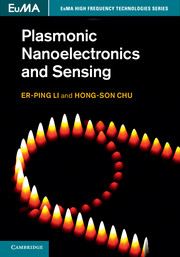Book contents
- Frontmatter
- Contents
- List of contributors
- Preface
- 1 Fundamentals of plasmonics
- 2 Plasmonic properties of metal nanostructures
- 3 Frequency-domain methods for modeling plasmonics
- 4 Time-domain simulation for plasmonic devices
- 5 Passive plasmonic waveguide-based devices
- 6 Silicon-based active plasmonic devices for on-chip integration
- 7 Plasmonic biosensing devices and systems
- Index
- References
4 - Time-domain simulation for plasmonic devices
Published online by Cambridge University Press: 05 March 2014
- Frontmatter
- Contents
- List of contributors
- Preface
- 1 Fundamentals of plasmonics
- 2 Plasmonic properties of metal nanostructures
- 3 Frequency-domain methods for modeling plasmonics
- 4 Time-domain simulation for plasmonic devices
- 5 Passive plasmonic waveguide-based devices
- 6 Silicon-based active plasmonic devices for on-chip integration
- 7 Plasmonic biosensing devices and systems
- Index
- References
Summary
In this chapter, the finite-difference time-domain method (FDTD) is developed and implemented for the modeling and simulation of passive and active plasmonic devices. For the simulation of passive devices, the Lorentz–Drude (LD) dispersive model is incorporated into the time-dependent Maxwell equations. For the simulation of active plasmonics, a hybrid approach, which combines the multilevel multi-electron quantum model (to simulate the solid state part of a structure) and the LD dispersive model (to simulate the metallic part of the structure), is used. In addition, the multilevel multi-electron quantum mode (solid-state model) is modified to simulate the semiconductor plasmonics. For numerical results, the methodologies developed here are applied to simulate nanoparticles, metal–semiconductor–metal (MSM) waveguides, microcavity resonators, spasers, and surface plasmon polariton (SPP) extraction from spaser. To enhance the simulation speed, graphics processing units (GPUs) are used for the computation, and, as an example, an application of a passive plasmonic device is examined.
Introduction
The diffraction limit was a challenge in the miniaturization of photonics devices, which restricted the minimum size of a component to being equivalent to λ/2. The new emerging ield of plasmonics has recently made it possible to overcome the diffraction limit of photonic devices. In plasmonics, the wave propagates at the interface of a metal and dielectric, and remains bounded. This feature allows the miniaturization of photonics devices below the diffraction limit. Some plasmonic structures, which guide and manipulate the electromagnetic signals, have been presented in the literature [1–7].
- Type
- Chapter
- Information
- Plasmonic Nanoelectronics and Sensing , pp. 99 - 138Publisher: Cambridge University PressPrint publication year: 2014

